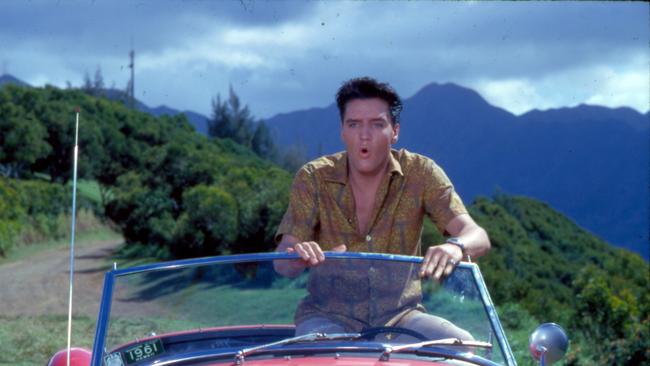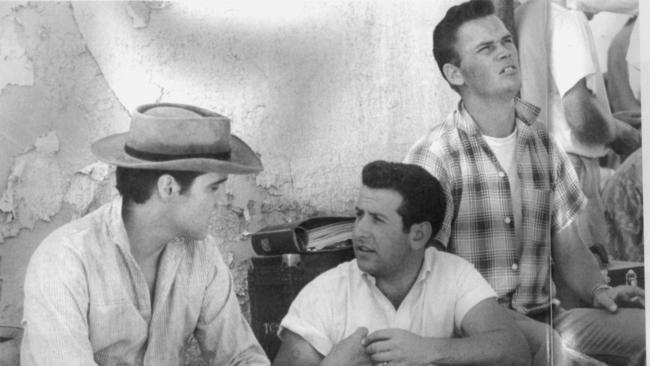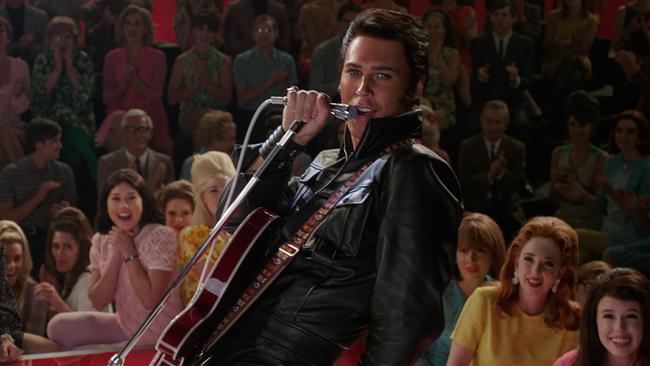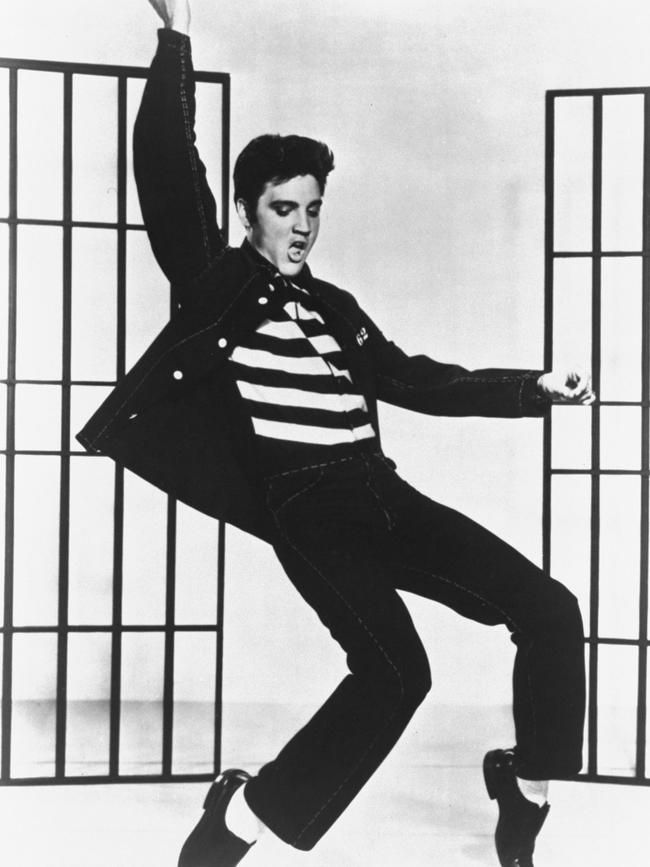Introducing the reel Elvis
Baz Luhrmann’s new biopic inspires David Stratton to delve into the King of Rock ’n’ Roll’s cinematic work and finds a promising actor who failed to move with the times.

Baz Luhrmann’s epic biopic, Elvis, opened in cinemas around the country on Thursday and prompted me to consider why I was never a Presley fan. This confession may sound like heresy, but in 1956, the year Elvis had his first big hit (Heartbreak Hotel in January), which was also the year his first film was released (Love Me Tender in November), my taste in popular culture lay elsewhere. I was 17 and although I followed popular music trends I was much more interested in the cinema.
As for music, I preferred Frank Sinatra, Ella Fitzgerald and Nat “King” Cole to rock ’n’ roll, and in 1956 the money I had saved up to buy a record album was spent not on Presley but on Sinatra’s Songs for Swingin’ Lovers!, which was released in March.
And although I was seeing practically every movie released in cinemas at that time, I didn’t see Love Me Tender. I was deterred by the fact that the film, which was originally titled The Reno Brothers, had been completed as a non-musical post-civil war drama but that the casting of the King of Rock ’n’ Roll as hero Richard Egan’s younger brother had resulted in the addition of four songs, songs that – many critics at the time suggested – were totally unnecessary and spoilt the mood of the film.

As far as Presley was concerned, then, my relationship to him got off to a bad start from which it never really recovered. When I finally saw Love Me Tender on television many years later what struck me about the film was what a promising actor Presley was and also how shocked his fans must have been when his character, Clint Reno, is killed at the end. Under the direction of Robert D. Webb – a very minor talent – Presley convincingly nailed the character of a young man torn between sibling loyalty and love for his brother’s fiancee (Debra Paget).
This was a promising start to Presley’s career as an actor, but he was rarely allowed to stretch himself as a performer on screen. Most of the 31 feature films he made between 1956 and 1969 are truly terrible, but occasionally he appeared in a movie made by a good director who succeeded in getting a convincing performance from him.
This was certainly not the case with his second film, Loving You (1957), a routine rags-to-riches story notable mainly for the casting of two very fine actors better known for their roles in the crime dramas of the 1940s known as film noir – Lizabeth Scott and Wendell Corey. Playing respectively a publicist and a veteran musician, Scott and Corey are criminally wasted playing second fiddle to Presley.
Jailhouse Rock, made the same year, is somewhat better; the title number is one of the best in a Presley film. MGM’s house director Richard Thorpe – who could turn his hand to films of any genre – did a competent job and Presley worked well with character actor Mickey Shaughnessy, who played another convict.

Presley’s fourth film, and the last he made before being conscripted into the US Army, was King Creole (1958), an adaptation of the Harold Robbins novel A Stone for Danny Fisher. This is one of Presley’s better films, probably because the director – Michael Curtiz of Casablanca fame – was a consummate professional. Playing a young misfit who lands a gig singing in the New Orleans nightclub that gives the film its title, Presley is very effective in the part and is memorably pitted against the film’s villain, a gangster played by Walter Matthau.
For the next two years Presley was in Germany serving in the 3rd Armoured Division in Friedberg. In the same unit was a young film enthusiast named Mike Harris who later relocated to Sydney and who, for a few years in the 1970s, became film critic for The Australian. Harris often spoke of serving alongside Presley and felt that the superstar fitted in well with his fellow draftees.
The first film Presley made on his release from military service was GI Blues (1960), which was exactly what his fans wanted – a fictionalised account of their hero’s life as a soldier in Germany. The innocuous entertainment was directed by veteran Norman Taurog, who years earlier had made musicals with Judy Garland and Mickey Rooney.
By far the best Elvis Presley film is Flaming Star (1960), which is set in West Texas, just after the civil war. Pacer (Presley) is the son of white rancher Sam Burton (John McIntire) and his Kiowa wife (Dolores del Rio). When Native Americans begin attacks on white settlers, Pacer attempts to act as mediator. This excellent western confines its two Presley songs to the opening credits and the first scene, in which Pacer entertains at a family celebration. Apart from that the film, made by Donald Siegel, a fine director, is a tense study of fractured and violent race relations in which all of the principal characters, Presley’s included, die at the end.

Given that Presley is said to be partly descended from the Cherokee his casting is propitious and he rises to the occasion with a memorable performance. Incidentally, Presley’s granddaughter, Riley Keough, last month won the Camera d’Or (best first feature as director) at Cannes for War Pony, a film about two young Native Americans growing up on a reservation.
Presley was almost as good in his next film, Wild in the Country (1961), an adaptation of a novel scripted by the talented Clifford Odets. Directed by the prestigious but literary Philip Dunne, the film was, like Flaming Star, not very successful commercially despite positive reviews and, as a result, Presley’s manager, Colonel Tom Parker, insisted that in future he be cast in a series of undistinguished musical romances.
The policy paid off at the box office, at least for a while. Presley next made Blue Hawaii (1961), another Taurog film which, though pretty ordinary, was one of Presley’s biggest hits thanks no doubt to a heady mixture of songs, surfboards and bikinis.
In the amusing Follow that Dream (1962) Presley plays a member of an eccentric, nomadic family who get into trouble with the law. Another veteran, Gordon Douglas, was the director. Kid Galahad, also 1962, was a remake of the 1937 Michael Curtiz film that had starred Humphrey Bogart, Bette Davis and Edward G. Robinson. A boxing drama, the remake – directed by the occasionally inspired Phil Karlson – was seriously undermined by the obligatory songs. Presley’s third film of 1962, Girls! Girls! Girls!, was typical of the mediocre vehicles into which the hapless superstar was cast from then on. Taurog was back for the third time with a silly film in which the Elvis character is trying to raise the cash to buy a boat he and his father had built.
What can you say about the films that followed? The titles pretty much speak for themselves: It Happened at the World’s Fair and Fun in Acapulco (both 1963), Viva Las Vegas, Kissin’ Cousins and Roustabout (all 1964, the last film featuring the bemused veteran of Double Indemnity, Barbara Stanwyck, in her penultimate feature film), Girl Happy, Tickle Me and Harum Scarum (all 1965), Frankie and Johnny, Paradise Hawaiian Style and Spinout (all 1966), Easy Come, Easy Go, Double Trouble and Clambake (all 1967), Stay Away Joe, Speedway and Live a Little, Love a Little (all 1968), Charro! – a belated return to Flaming Star territory that came too late – and The Trouble with Girls, both 1969. Presley’s final film, also made in 1969, was Change of Habit in which Presley plays a doctor and Mary Tyler Moore a nun.
That was the end of Presley’s movie career. Times had changed and, as far as his film choices were concerned he hadn’t changed with them. New directors such as Francis Ford Coppola, Martin Scorsese, Steven Spielberg and Roman Polanski were about to transform American cinema; Presley’s movies now seemed like relics of the past.
For the rest of his life he abandoned cinema in favour of live concert performances, most of them in Las Vegas. It seems a shame that his obvious potential as an actor was never fully realised.
In August 1977 I was driving through Europe with a friend. We crossed the border from Germany into Denmark and stopped for a coffee in the town of Padborg. Outside a newsagent’s was a poster that read: Elvis Presley er dod. The meaning was obvious but it was still something of a shock; Elvis was only 42.
Two years later, in 1979, John Carpenter made a pretty good biography of Elvis for television, with Kurt Russell as the superstar. And now we have Baz Luhrmann’s dazzling 4½-star triumph – finally I can put aside my prejudices and revel in a Presley movie.




To join the conversation, please log in. Don't have an account? Register
Join the conversation, you are commenting as Logout